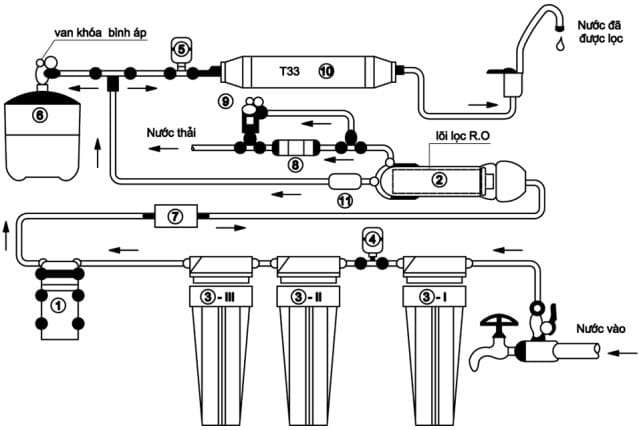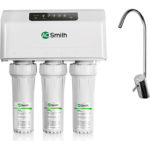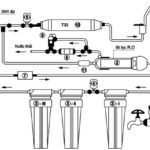You want to install water filters after buying home but don’t know how to install it correctly? Learn right away through this article.

2. How to install the water filter correctly
Step 1: Split the incoming water at the sink or water meter, close the incoming water tap when not yet installed into the machine.
Step 2: Remove the plastic wrap of the filter cores number 1, 2, 3 and put them in the corresponding filter cups. Then tighten filter cups number 2 and number 3, filter cup number 1 should be tightened moderately to loosen the air to avoid being trapped.
Step 3: Connect the large RO cable to the input port of filter cup number 1. When installing, make sure the screw is wrapped by Teflon tape and fully tightened to optimize the connection force between the RO cable and the screw.
Step 4: At the outlet of filter cup number 3, remove the RO cable connected from this outlet to the inlet of the RO membrane, then take the small RO cable (outer section) to connect directly from the outlet of filter cup number 3 to the drain to prepare for the rinsing process of filter cores number 1, 2, 3.
Step 5: Plug in the RO water filter and open the water valve of the stainless steel inlet to start rinsing the preservatives of filter cores number 1, 2, 3. This process takes 20 minutes.
Step 6: During the rinsing process, if water overflows from filter cup number 1, tighten filter cup number 1 again. Note that the filter cup should not be tightened too tightly to loosen 1-2 turns. Overtightening will cause the machine to run with air but not filter water.
Step 7: After about 20 minutes of rinsing filter cores number 1, 2, 3, unplug the power cord, then reconnect the RO cable from the input of the RO membrane shell to the input of filter cup number 3 (as originally installed)
Step 8: Wear gloves and remove the outer plastic bag of the RO membrane. The installer should wear gloves for sanitation and to avoid adding dirt to the membrane.
Step 9: Soak the RO membrane with pure water, it is possible to use bottled pure water to evenly permeate the water through the RO membrane structure to expand evenly and ensure the maximum efficiency of the membrane.
Step 10: Insert and press the RO membrane tightly into the inside of the membrane shell, with the black sealing ring of the membrane facing inward.
Step 11: Cover and tighten the RO membrane shell. Use pliers to tighten the nut to prevent water leakage.
Step 12: Connect the small RO cable from the waiting position of the Flow valve to the drain of the house along the drain line.
Step 13: Rinse the RO membrane. At the outlet of the RO membrane (the connection point with the blue line), remove the blue cable, then connect the small RO cable (outer section) to the household drain.
Step 14: Plug in the machine to start the process of rinsing the preservatives for about 20 minutes.
Step 15: After finishing rinsing the RO membrane, reconnect the original RO cable installation of the RO membrane shell. And connect the outlet cable of the pure water of the membrane shell to the pressure tank
Step 16: From the pressure tank, connect to the input port of filter core number 5. Filter cores number 5 and number 6 are ready to be connected.
3. Notes for installation and use of the RO water filter
| Water supply source | The quality of the water input meets the standard QCVN 02:2009 / BYT. |
| The water source supplied to the RO machine has a temperature of 5-50 °C. If the water temperature is outside the specified range, it will damage the machine. | |
| RO machine installation location | Choose a convenient installation location for water and wastewater connections. |
| To ensure the machine works well, the water column height down to the RO machine must be greater than 2m. | |
| Place the water filter on a flat surface in a vertical position | |
| Must connect the low-pressure valve | If the water pressure is too weak, the RO water filter cannot operate. In that case, connect the low-pressure valve by pressing the switch to make the RO filter operate. |
| In case of connecting or disconnecting the low-pressure valve, always maintain the water supply to the machine. | |
| Use and storage | The main parts of the RO machine are made of plastic, so when using them, be gentle, do not put heavy objects on the RO machine, and keep them away from fire. |
| Observe whether the machine is intact to ensure safe use. | |
| Rinsing the RO membrane | It is recommended to open the RO drain valve daily to rinse the RO membrane, helping to remove some dust and impurities from the RO membrane, extending the life of the RO membrane and improving the quality of pure water. |
| The time to open the RO drain valve is about 1 minute. | |
| First-time use of the RO machine | For the first time using the RO machine, remove the first 1-2 bottles of water from the pressure tank. |
| The RO machine starts operating, the ppm (TDS) index in pure water will be slightly higher. After operating for a while, the index will stabilize. | |
| In the first time using the RO machine or after each time losing water or power…, do not take hot water, only take cool pure water to ensure that the water is filled in the tank. | |
| Do not disassemble or change the installation diagram | The installation diagram of the RO machine is optimized by the supplier, and any changes, no matter how small, will cause the RO machine to operate inaccurately, the water quality will not be guaranteed. |
| Note for the NEO AMBIENT – HOT line |
|
Unique Feature Found Only in Under-Sink Water Filters – Cabinet-mounted
Nowadays, water filters have become an essential part of every Vietnamese household, providing a better quality of life and ensuring the safety and health of our loved ones. There is a wide variety of options available, with constantly updated designs and new features, providing consumers with more choices. One of the latest products on the market is the under-sink water filter – designed to be placed discreetly under the kitchen cabinet.
































